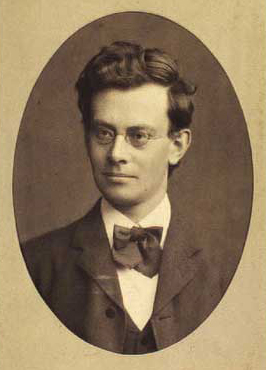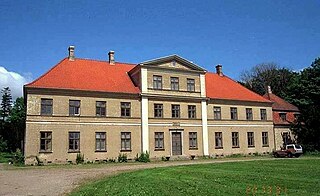
Christopher Puggaard (or Hans Christopher Wilhelm Puggaard, born on 23 May 1823 in Copenhagen, and died on 14 August 1864 in Caen, Normandy) was a Danish geologist.

Christopher Puggaard (or Hans Christopher Wilhelm Puggaard, born on 23 May 1823 in Copenhagen, and died on 14 August 1864 in Caen, Normandy) was a Danish geologist.

Puggaard was born on 23 May 1923 in Copenhagen, the son of the son of Hans and Bolette Puggaard. His elder brother was the later businessman Rudolph Puggaard. He studied at Roskilde Cathedral School, whereupon he studied in the polytechnic school and got his diploma in natural science in 1846. He was fascinated in particular by the classes of the country's leading geologist, Johan Georg Forchhammer. [1] He travelled then to further his studies in England and Paris and later Italy, together with his friend the painter Wilhelm Marstrand.

In 1851, Puggaard published in Danish his book on the geology of the Island of Møn (Möens Geologie. Populært fremstillet. Tillige som Veiviser for Besögende af Möens Klint) which was rewarded with the gold medal of the University of Copenhagen. The book was later slightly changed and translated into German under the title Geologie der Insel Möen. Following this publication, the University of Bern gave him the title of Doctor in Philosophy. The book was illustrated by some of the best painters of the Danish Golden age, such as Christoffer Wilhelm Eckersberg, P.C. Skovgaard and Vilhelm Kyhn.
Based on the sedimentary layers and fossils, Puggaard provides a fantastic narrative on how our planet developed from a globe of fluid stone into the progressive development of life. After being submerged in an ocean inhabited with tropical species, the site of Møn became covered by an Arctic Ocean with icebergs, and finally emerged as a wooded island populated by Stone Age men and mammoths. [2] In this regard his views were opposed to Forchhammers and ahead of their time. [3]
Puggaard also later published various contributions on the geology of the Sorrento Peninsula and the Alps.
Puggaard died young, while doing research on the cliffs in Normandy.
Puggaard was married to Louise Henriette Amalie Wormstrup (1817–1911). They had three daughters: Clara Louise Pauline Puggaard. Alice Helene Puggaard and Gerda Puggaard. Puggaard lived in the Hjuleberg Manor in Halland, Sweden. He was the grandfather of novelist Jacob Paludan.
The Puggaard Stone, a giant stone located in the water off Møns Klint, is named after him. [4]


Christoffer Gabel was a Danish statesman. He was the father of Vice Governor-general of Norway, Frederik Gabel.

Friedrich Wilhelm, Duke of Schleswig-Holstein-Sonderburg-Glücksburg was a German-Danish prince and officer who was the Duke of Schleswig-Holstein-Sonderburg-Beck from 1816 to 1825, and the Duke of Schleswig-Holstein-Sonderburg-Glücksburg from 1825 to 1831. Friedrich Wilhelm is the progenitor of the House of Glücksburg.
Karen Andersdatter was the Danish mistress of King Christian IV of Denmark-Norway and the mother of one of his three illegitimate but acknowledged children, Hans Ulrik Gyldenløve.

Johan Georg Forchhammer was a Danish mineralogist and geologist.
Dansk Biografisk Leksikon is a Danish biographical dictionary that has been published in three editions. The first edition, Dansk biografisk Lexikon, tillige omfattende Norge for tidsrummet 1537–1814 was published in nineteen volumes 1887–1905 under the editorship of the historian Carl Frederik Bricka. The first edition, which is in the public domain is available online at Projekt Runeberg.

Carl Frederik Bricka was a Danish archivist, historian and biographer.

Thomas Vilhelm Pedersen was a Danish painter and illustrator who is known for his illustrations for fairy tales of Hans Christian Andersen. He was the first artist to illustrate Andersen's works. His drawings were converted into wood prints and used in the Danish and German editions.

Carl Christian Vilhelm Liebe was a Danish politician representing first the National Liberal Party and later the conservative Højre, lawyer and speaker of the Landsting, a chamber of the parliament. He was an elected member of the Folketing from 1861 to 1866, and a royally appointed member of the Landsting from 1866 to 1895.

Johannes Frederik Johnstrup was a Danish professor, geologist and paleontologist. He was the founder of the Danish scientific periodical Meddelelser om Grønland.

The Ordre de l'Union Parfaite was created by Queen consort Sophie Magdalene of Denmark and Norway on 7 August 1732 to celebrate the tenth anniversary of her happy marriage with King Christian VI of Denmark and Norway. It was given to both men and women. Its motto was In felicissimæ Unionis Memoriam.
Johannes Nicolai Georg Forchhammer was a Danish philologist.
August Friedrich Wilhelm Forchhammer was a jurist and historian from the Duchy of Schleswig.

Friedrich Christian Carl Heinrich Münter was a German-Danish scholar, theologian, and Bishop of Zealand from 1808 until his death. His name has also been recorded as Friederich Münter.
Johan Georg Frederik Ræder was a Danish civil servant and writer.

the Güldencrone family, also spelled Guldencrone and Gyldenkrone, is a Danish and Norwegian noble family with the rank of fief baron.
Anders Foss was a Norwegian clergyman and Bishop of Bergen.

Rudolph Puggaard was a Danish merchant, patron of the arts and philanthropist.

The Western Regional Command was the overall command of all Royal Danish Army units in Jutland and on Funen. It was split into four military regions, and was responsible for the regional defence. In 1990, the Regional Commands were disbanded and control was collected at the newly created Army Operational Command.

The Eastern Regional Command was the overall command of all Royal Danish Army units on Zealand. It was split into four military regions and was responsible for regional defence. In 1990, the Regional Commands were disbanded and control was collected at the newly created Army Operational Command.

The General Staff of Denmark was a top authority in the Royal Danish Army and was responsible for war preparations, studies and planning.